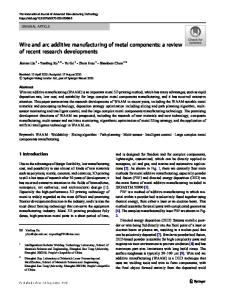Solid-State Metal Additive Manufacturing: A Review
- PDF / 3,556,446 Bytes
- 22 Pages / 593.972 x 792 pts Page_size
- 3 Downloads / 434 Views
https://doi.org/10.1007/s11837-020-04260-y Ó 2020 The Minerals, Metals & Materials Society
ADDITIVE MANUFACTURING: BEYOND THE BEAM TECHNOLOGY
Solid-State Metal Additive Manufacturing: A Review NIHAN TUNCER
1,2,3
and ANIMESH BOSE1
1.—Desktop Metal, Inc., 63 Third Ave, Burlington, MA 01803, 2.—e-mail: [email protected]. 3.—e-mail: [email protected]
USA.
Although a significant amount of technical, commercial, and academic resources have been invested in laser and electron beam-based additive manufacturing (AM) of metals and alloys over several decades, challenges and limitations associated with repeated local melting and processing complexity along with the cost of equipment and operation have sparked interest in research on solid-state AM methods as an alternative. This paper reviews the capabilities and challenges of major solid-state metal AM techniques by dividing it into two broad categories (plastic deformation based and sinter based) depending on the metallurgical bonding mechanisms, range of processible alloys, and resulting microstructures. The limited and recent data available in literature show that, while deformation-based AM techniques are primarily limited to relatively ductile alloys, a larger variety of materials are suitable for manufacturing through sinter-based AM. Deformation-based methods generally refine the microstructure by recrystallization, while in most cases sinter-based AM methods lead to grain growth due to high-temperature processing and a more isotropic microstructure. Among the solidstate AM methods summarized here, the binder jetting and additive friction stir AM methods stand out with isotropic microstructures and mechanical properties close to the wrought properties.
INTRODUCTION Additive manufacturing (AM), also commonly referred to as three-dimensional (3D) printing, allows layer-by-layer building of complex shaped parts from engineering materials without the use of tooling. A myriad of engineering materials, such as polymers, polymer-matrix composites, ceramics, metals and alloys, and metal- and ceramic-matrix composites, have been fabricated using various 3D printing methods.1–7 The early commercial applications of 3D metal printing were laser-based technologies. The advancement of laser technologies and the development of electron beam processing led to the proliferation of commercial AM technology. Developments of commercial 3D printing started around the 1980s, with early demonstration being based on curing of photopolymers by ultraviolet lasers that formed the basis of 3D Systems Corporation. This was soon followed by 3D printing by melting of powdered feedstocks using laser beams. The ability of 3D printing to create viable commercial metal alloys was brought to the limelight by the
General Electric Aero LEAP fuel nozzle that combined 18 components into a single one using laser beams.8 Electron beam (EB)-based technologies followed, enabling the fabrication of several different high-temperature metals and alloys.9 Though the early commercial applicat
Data Loading...











